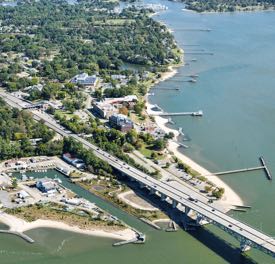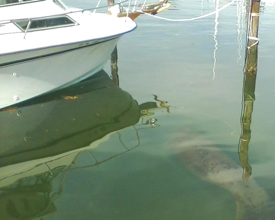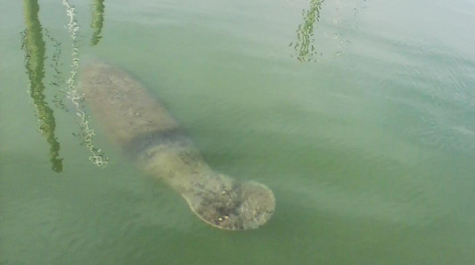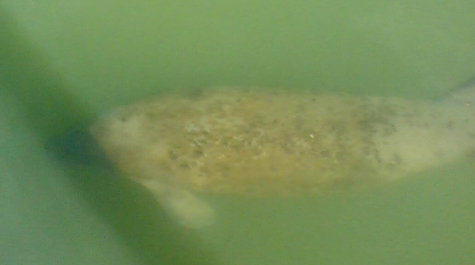VIMS researchers observe one of Chesapeake Bay’s rarest creatures
Researchers at the Virginia Institute of Marine Science spend a lot of time in, on, and near the water, and are thus used to seeing some pretty uncommon marine life.
But when seagrass researcher Corey Holbert glanced into the waters of the VIMS Boat Basin on the day after Halloween, you can excuse him for doing a double take. Where the basin’s access channel empties into the York River—right below the Coleman Bridge—lolled a 6- to 8-foot-long manatee.
“What in the world is that?’ Holbert remembers thinking. “It went under water right after I first saw it, so at first glance I wasn’t sure what it was—a seal, a shark? I just had no idea.”
Normally found in the warmer waters of Florida and the Caribbean, manatees are rare visitors to Chesapeake Bay, especially outside the summer months. The 65° water temperature in the York River on the day of Holbert’s sighting was several degrees below the animals’ preferred lower limit of 68°. Indeed, the animals are subject to hypothermia in waters below 60°.
 As Holbert stood on the edge of the canal wondering what he had seen, the mysterious apparition suddenly reappeared, and this time he got a good look. “It was fairly close to the top of the water and I could see that broad, flat tail and its distinctive face and snout. When I saw those features I knew it was a manatee.”
As Holbert stood on the edge of the canal wondering what he had seen, the mysterious apparition suddenly reappeared, and this time he got a good look. “It was fairly close to the top of the water and I could see that broad, flat tail and its distinctive face and snout. When I saw those features I knew it was a manatee.”
Excited to share his discovery with colleagues, Holbert contacted VIMS Professor Robert JJ Orth, fellow seagrass researcher Paul Richardson, and Ph.D. student AJ Johnson; together they spent the next 20 minutes watching and filming the creature before it made its way into the York River. “Every three or four minutes it would poke its head up and take a breath,” says Holbert, “and that’s when we would get the best look.”
|
Any member of the public who observes a manatee is asked to call the Virginia Aquarium's 24-hour Stranding Response hotline at 757-385-7575. The Stranding Team will need an exact location and photos or video of the animal. People are asked to maintain a safe distance from any manatee to prevent disturbance or potential injury. |
Adding to their surprise was the manatee’s direction when leaving—instead of taking a left-hand turn toward the Bay mouth and warmer, more southerly waters; it hung a right and began to swim even farther up the York River.
Orth, whose career at VIMS began in 1969, says this is his first manatee sighting in the Bay. But his knowledge of the species’ biology and ecology makes him concerned about this animal’s fate.
{{youtube:large|zRuPtwj1G6s, Watch as the manatee enjoys the VIMS Boat Basin. © VIMS}}
“We’re not sure what will happen to this guy, as they don’t like cold water,” he says. “In Florida, when it gets really cold, the densest concentrations of manatees occur in the plume of warm water released by power plants.”
Holbert shares Orth’s apprehension. “Who knows where it will head or what will become of it?,” he asks. “I’m definitely concerned, what with the water temperatures dropping. Hopefully it will make its way out [of the Bay] and head south, but there’s really no way of knowing.”
The sighting of the manatee by a team of seagrass researchers is especially ironic, as the underwater plants they study are this species’ favorite food.
“There’s quite a bit of eelgrass on the shelves along the mouth of the York River,” says Orth, “but this guy was heading upriver towards West Point, where there’s nothing for it to eat, unless it’s going to eat macroalgae—sea lettuce or Argardiella.”
There’s some evidence to support that idea, as Holbert and the others saw the manatee exhibit what they thought was feeding behavior in the boat channel, where macroalgae is the only submerged vegetation.
“We could see these big sediment plumes around it—we don’t know if it was feeding on the macroalgae that grows on the bottom or just hanging out,” he says. Manatees are known to eat macroalgae elsewhere in their range.
Adding to the day’s mystery is that a manatee was also spotted around 11 a.m. that morning in the Perrin River, about 5 miles downriver from VIMS near Crown Pointe Marina. It could be the same animal—a manatee can travel fairly long distances at speeds up to 5 miles per hour and would have been helped along by the incoming tide—but because none of the observers were able to get a good look at the body, that question will remain unanswered.
 Manatee researchers can tell individuals apart by the unique pattern of propeller scars that many bear along their backs. Boat strikes are one of the leading causes of death among manatees, and one of the reasons they are listed as threatened under the Endangered Species Act. Regulations and education have improved the manatee’s chances at survival in recent years, but the species’ U.S. population is still estimated at only about 6,000 animals.
Manatee researchers can tell individuals apart by the unique pattern of propeller scars that many bear along their backs. Boat strikes are one of the leading causes of death among manatees, and one of the reasons they are listed as threatened under the Endangered Species Act. Regulations and education have improved the manatee’s chances at survival in recent years, but the species’ U.S. population is still estimated at only about 6,000 animals.
“Who knows if it was the same manatee or a different one?” asks Holbert. “I wouldn't be surprised either way. Given the small number of people who actually have their eyes on the Bay, and the vast amount of water it holds, I would have to imagine that more of these critters make it in than we realize—we might just never see them.”
The last sighting of a live manatee in the Chesapeake region came in July 2016, when an animal was spotted near Rudee Inlet. A dead manatee was discovered in Maryland’s Patapsco River in November 2016. The Bay's most famous manatee is Chessie, a tagged and easily identified animal that first appeared in 1994 and was subsequently seen in 2001 and 2011. There is some thought that manatees may be visiting the Bay more regularly due to climate change and the Bay’s warming waters.



